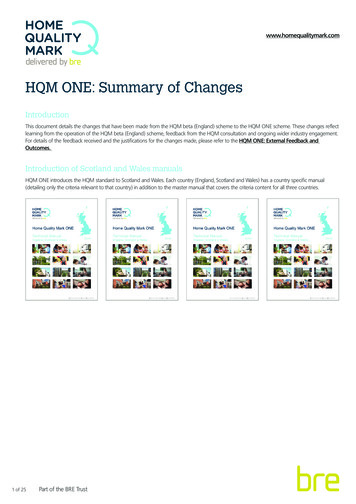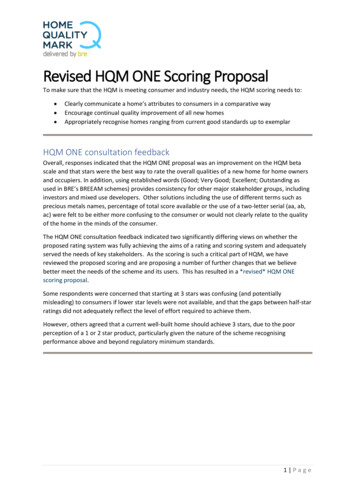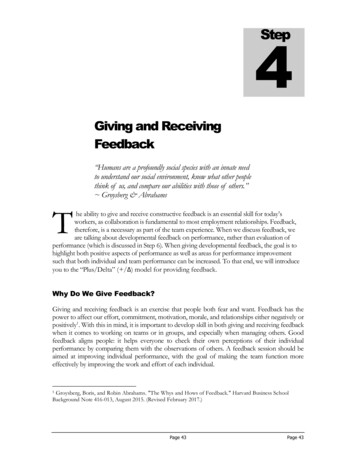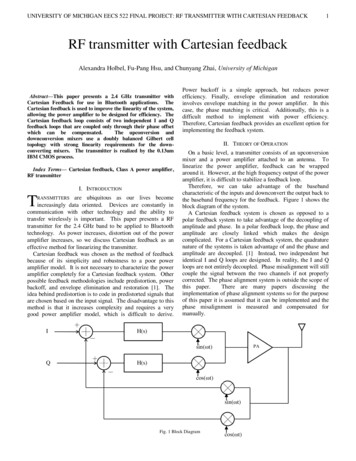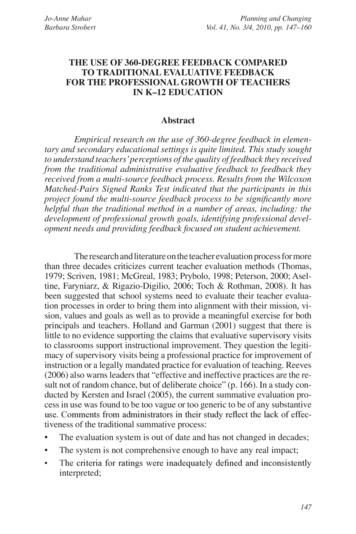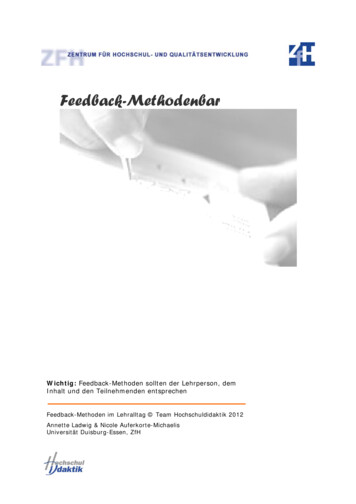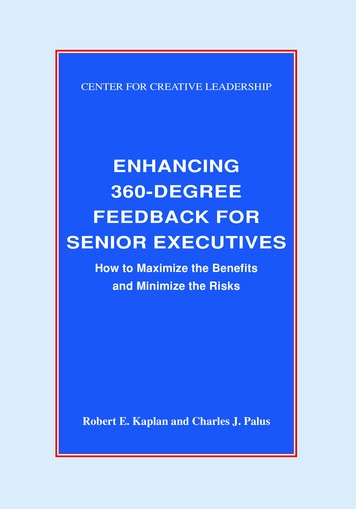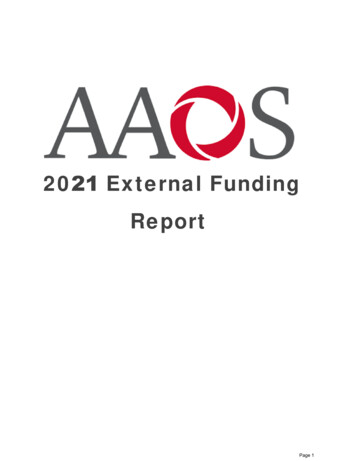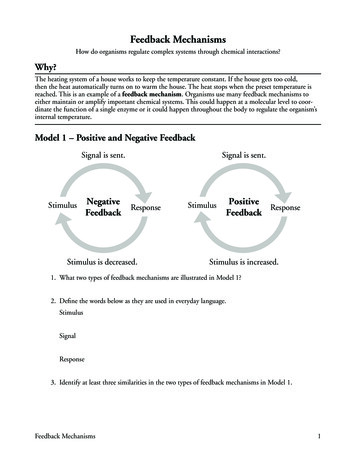
Transcription
www.homequalitymark.comHQM ONE: External Feedback and OutcomesIntroductionFeedback and consultation has been a key pillar in the development of Home Quality Mark ONE. It is a two-way process and this reportsummarises the feedback received from stakeholders on the draft version of Home Quality Mark ONE and how we have taken this forward intothe final version of the scheme.We consulted and received feedback in a number of ways, through formal questionnaires, BREEAM organised workshops in person, BREEAMonline workshops, face to face meetings, workshops and events organised by partner organisation, construction site and factory visits andthrough the operation of the beta version via assessor technical queries and other valuable feedback. HQM ONE has also completed a formalprocess of consultation and approval to UKAS standards through the independent BRE Global Governing Body and Peer Review.In considering feedback we have worked to ensure a balance between, ensuring robustness, sound science, technical practicality and also valuefor money in terms of process, cost and benefit.The latest formal consultation process is part of a long line of consultation and engagement, which includes formal BRE Global processes.Summary of IndustryWorkshops 2014https://goo.gl/3zVY9JLaunch of HQM Brandand Overview documentMarch 2015https://goo.gl/fXjxz22014Launch of HQM BetaEngland, December 16BRE GlobalPeer reviewersFinal Reviewby BRE GlobalIndependentGoverningBody2017Launch ofHQM ONEEngland, Wales,ScotlandAugust 20182018Continuous engagement with developers, consultants, contractors, representative bodies, local authorities, financiers etcConsultation, Summer2014 - The Future ofSustainable Housing,Creating a new Standardwww.bre.co.uk/fshHQM IndicatorSurveyhttps://goo.gl/oZWNUcTechnical Consultation,Summer 2015 HQM Betawww.homequalitymark.com/consultation2015HQM Beta operation and feedbackTechnical Consultation,Winter 2017 - HQM w up ScoringConsultation 2018 llowupThere were five overarching aims in the development of HQM ONE. These were;1)Take forward feedback from the beta version2)Ensure there was a robust “quality base” for the standard3)Create versions tailored for use in Scotland and Wales4)Ensure that the scheme clearly communicated to its users and their customers through the scoring and rating system.5)Update issues to reflect new science and align with other BREEAM schemes where appropriate.A full overview of the changes between HQM Beta and the final version of HQM ONE are set out in the summary of changes document.1 of 26Part of the BRE Trust
www.homequalitymark.comSummary of Feedback ReceivedThe tables on the following pages sets out in summary form the breadth of feedback received throughout the engagements and consultationprocess. Outcomes and the context for these are also set out. Individual consultation responses have been grouped into general themes in theinterests of keeping this document to a manageable length and no attribution is made for these comments.These comments are grouped into separate tables covering Overarching Themes, Our Surroundings, My Home, Delivery and the Scoring andRating System.Overarching consultation response themesRef.IssueFeedback receivedOutcomeContext for outcomeThe credits available for technical categories in HQM are determined by how important theyare for delivering sustainable and quality development.These are shaped by the underlying BREEAM weightings that inform credit weightings acrosskey technical categories for other schemes within the BREEAM family based on stakeholderengagement, research and feedback.1HQM ScoringThere were a numberof responses queryingchanges to creditallocations in variousissues throughout themanual.NotedSpecific credit allocations within issues are determined by the value that the criteria havefor achieving sustainable, quality outcomes. The feasibility of achieving these outcomes arealso considered, to ensure that relative value is being achieved based on the level of effortand investment required, within the control of the developer. For more details on how theseweightings were determined, please see the BREEAM briefing paper ‘New Methodology forGenerating BREEAM Category Weightings’ al/).These weightings have been further refined for HQM ONE, based on consultation feedbackreceived during the Beta stage to take account of the scope of coverage for this schemeand to better reflect the priorities for new-build homes, including an increased emphasis ontechnical criteria that help to deliver high-quality homes.22 of 26HQM ScoringA number ofresponses highlightedspecific scenariosthat may find theachievement ofparticular creditschallenging, or wherecredit achievementin a particular issuemight result in a creditreduction in anotherissue.Part of the BRE TrustNotedIt is important to remember that the intention of the HQM is to act as a scheme thatrecognises homes that have been built to go beyond regulatory minimum requirements, andexpresses the benefits of this to consumers. The content of the scheme therefore looks tocover a holistic range of technical topics and offer developers choice as to how to achievetheir desired rating. This allows it to recognise homes built in different areas, with differentspecifications and for different purposes. There will inevitably be some technical elements thatare harder or easier to achieve for specific scenarios (i.e. due to location, house type etc.), andsome scenarios where achievement of credits against particular issues may result in fewercredits being achievable in other issues.The scheme has been built to account for these scenarios, and it is not expected thata scheme would (or could) be able to achieve maximum credits in all areas. The scorerequirements for both the star rating and indicator levels reflect this (with 5 star and level 5requiring achievement of 80% of the total score available).However, a further review of this has been completed for HQM ONE. Where possible,different benchmarks have been used in criteria to recognise improvements for certain areas,relative to the project. For example, recreational space standards for houses in urban locationsor apartments part of a block, have been made easier to achieve compared to homes in rurallocations.
www.homequalitymark.comRef.34563 of 26IssueMinimumRequirementsQuality issuesEcology issuesSupersededstandardsFeedback receivedGenerally, responsesto the introducedminimum requirementswere positive. Therewere however someconcerns raisedover the timingsassociated with theserequirements dueto how early somerequirements need tobe met.Responses broadlysupported theincreased emphasison criteria that focuson delivering highquality. However, somecomments suggestedthat some of therequirements shouldbe standard practice,others said that theyare often not deliveredin practice, and thatHQM should help withthis.OutcomeStakeholder engagement, feedback and research suggested that having minimumrequirements is essential for the integrity and value of HQM. They help to ensure that everyassessed home meets a certain level of performance in key areas that all homes should meetbefore they should be recognised with credits being awarded for going significantly beyondminimum standards. This helps to increase the value of HQM-assessed homes and giveconsumers confidence about the claims being made by developers.PartiallyacceptedEarly consideration is vital in achieving the best outcomes because it gives time tomeaningfully shape key decisions that influence processes and outcomes before it becomescostly or difficult to do later on. This is a recurring feature of other schemes within theBREEAM family.However, it is appreciated that early involvement of an HQM assessor is not always possible.Therefore, flexibility has been added to HQM ONE, where it can be assured that the sameoutcomes are being achieved across certain issues. The new manual does this by signallingthe RIBA stage that an activity would typically happen at, rather than as a strict requirement initself and alternative approaches can be recognised where these achieve the same benefits.Ensuring HQM ONE recognises and helps deliver a quality product that meets consumers’expectations is essential for achieving HQM’s aim of building consumer trust, differentiatingand delivering quality and sustainable homes. Three key areas that lead to a quality home are:1. Well thought through design and specification2. Construction quality and adherence to design aspirationsAccepted3. Good customer supportThe issues that fall under these three main areas were reviewed, amended and enhancedwith a view to bringing increased value to both the end user and the home building industry.The requirement for build quality inspections at key stages throughout construction hasbeen changed to a minimum requirement, due to its importance in delivering quality homesthat consumers can trust. There is flexibility to allow for different methods of achieving thisminimum requirement depending on what is appropriate for the particular project beingassessed.Several commentswere made abouthow the ecologyissues in the StrategicEcology Framework(SEF) should work forHQM.NotedA number ofresponses identifiedsuperseded standardsthat were referred toin various technicalissues.AcceptedPart of the BRE TrustContext for outcomeThe BREEAM UK Strategic Ecology Framework (SEF) has been implemented across HQM andothers within the BREEAM family of schemes, as they are updated. This involves developmentof the assessment issues, and appropriate alignment across BREEAM schemes and builtenvironment lifecycle stages. Stakeholders were consulted separately to ask for feedback onthis. The underlying core content is essentially the same for HQM as it is for BREEAM NewConstruction 2018 but presentationally it has been adapted to communicate requirements ina way that is consistent with HQM’s manual.The HQM ONE consultation comments regarding ecology were considered as part of theHQM adaption of the SEF core ecology issues and will be responded to as part of thestrategic consultation response for that package of work. See here for more ecology-framework/Some respondents highlighted that standards referred to had been superseded. These havebeen amended throughout the manual.
www.homequalitymark.comRef.78910IssueFeedback receivedClaritySome responseshighlightedgrammatical orformatting issueswithin the manual.Many responses alsohighlighted areaswhere there was alack of clarity in therequirements.AcceptedStatutoryrequirementsSome responsesqueried therelationship of theHQM criteria withother menttoolSome responseshighlighted issues withthe online tool.EnergySeveral responseswere made regardingfuture considerationsof energy infrastructureand calculationmethodologies.OutcomeContext for outcomeAny grammatical or formatting issues highlighted have been amended in the manual.This also applies to feedback highlighting that this has led to a lack of clarity. We have alsocompleted our own review of the manual to identify any other issues that have requiredclarification.All guidance notes have also been reviewed and updated and hold a lot of the clarityrequested in the feedback. We will continue to monitor clarity through feedback receivedpost-publication of the manual and will reissue the document as appropriate where issuesare identified.All HQM criteria are designed to reward performance beyond the regulatory minimum.However, where a statutory requirement exists that is more stringent than those in HQM, thestatutory level must be met for the credit to be awarded.Further clarification has been added into the manual for issues where this was unclear.AcceptedThe HQM online assessment tool is being updated to reflect the technical changes, and willalso include additional functionality in response to feedback received during the consultationand throughout the operation of the HQM beta stage. The updated tool will be availablefrom the 24th of August 2018.Some of the recommendations made have been incorporated into the manual (see specificissue feedback below).PartiallyacceptedAll recommendations have been logged and will be kept under review. It has not beenpossible to incorporate all suggestions at this time due to a lack of standards relating to suchtechnologies, or evidence confirming energy performance. We are however aware of variouswider industry discussions around future energy infrastructure and calculation methodologiesand will continue to monitor how these might affect HQM.OutcomeContext for outcomeNotedWhile the criteria remain, the number of credits has been reduced and reallocated to issueswhich developers have more control over.Our SurroundingsRef.IssueFeedback receivedCategory: Transport & Movement114 of 26PublicTransportAvailabilityThe criteria for theimproved local servicewill be difficult forsmall developments(particularly in rurallocations), and thosedevelopments thatalready have a veryhigh AI score.Part of the BRE TrustFor further details regarding HQM scoring approach, please see ref. item 1 and 2 above.
www.homequalitymark.comRef.12IssueFeedback receivedSustainableTransportOptionsFeedback suggestedthat for the electricvehicles chargingpoints criteria, creditsshould be awardedaccording to differentcharging powers,and should accountfor passive chargingprovision. It was alsonot clear how thecriteria should beinterpreted for privateparking scenarios.OutcomeContext for outcomeThe ‘Electric vehicle charging points’ criteria have been updated. They now split the criteriainto private and communal provision requirements.AcceptedIn response to the feedback received, credit allocation has also been revised so that they areawarded according to the charging power. For communal settings, a calculation has beenintroduced that also accounts for fast charging infrastructure.BRE will continue to monitor potential future changes in regulation in this area.13SustainableTransportOptionsIt was felt that thecar club requirementswere too strenuous,particularly includingthe requirement forhybrid/electric carprovision.14LocalAmenitiesThe lists provided forcriteria 1 and 3 areunclear as they are notdefinitive.AcceptedThe lists of ‘Key local amenities’ and ‘Beneficial local amenities’ within the criteria have beenamended to improve clarity.RecreationalSpaceTo define GrossDevelopment Area(GDA).AcceptedA definition for GDA has been included.RecreationalSpaceFeedback suggestedthat the growingspace criteria werenot applicable toindividual growingspace provision, andthat they were overalltoo stringent, effectingthe accessibility of thecriteria.AcceptedWe recognise the need to acknowledge different growing space provisions. The growingspace criteria have been revised to differentiate between private and communal growingspace scenarios. They also now account for the difference in opportunities between flat/house and urban/rural scenarios.RecreationalSpaceSome respondentsfelt that the privatespace requirementswere too onerous, inparticular the 100m2requirement formaximum credits for5 bedroom homes.PartiallyacceptedThe criteria relating to the car club has been retained. However they have been restructuredto offer credits where the home has access to a car club, with an extra credit available where60% of the vehicles available from the car club are hybrid/electric vehicles.Whilst we recognise the benefit of having access to a car club, it is important that thereis further recognition and incentive for car clubs to offer hybrid/electric vehicles and thesupporting infrastructure.Category: Outdoors1516175 of 26Part of the BRE TrustPartiallyacceptedOur research of approved developments and local plans suggests that these requirements areachievable and in a number of cases, required in the local plan. It is worth mentioning that themaximum credits awarded for private space are intended to recognise those developmentswith a high provision of private space and are unlikely to be achievable in all locations. Theaccessible recreational spaces, and communal space criteria are designed to allow flexibilityin the achievement of recreational space credits and may be used to compensate for lowerperformance in private space in some instances.We have also amended the credit scales in some instances for the private space requirementsfor 3 credits. This is to ensure a more linear scale increase in reward between therequirements.
www.homequalitymark.comRef.IssueFeedback receivedOutcomeContext for outcomeAcceptedClarification has been added to confirm that where the EA has set more onerousrequirements, these requirements must be met in order to achieve this criterion.Category: Safety and Resilience181920216 of 26Flood RiskThe 600mm figureis from EA standingguidance. TheEnvironment Agencyrequirement willusually be site specificand may depart fromthis.Managingthe Impact ofRainfallThere was concernthat three credits forthe ‘water quality’criteria are notsufficient to encouragecompliance with theWater FrameworkDirective.Managingthe Impact ofRainfallIt was proposedthat the SuDSManual should bereferenced in terms ofassessing risk and theappropriate surfacewater treatmentmethod(s), and thatthe reference to PPG3should be removedas this has beenwithdrawn by the EA.SecurityIt was queried whythis issue carries thesmallest number ofcredits of any issuein this sub-category(Safety & Resilience).Part of the BRE TrustPlease refer to item ref. 8 above for further details.NotedAcceptedThe EU Water Framework Directive exists as a regulatory control; to tackle water quality. This ishowever a requirement for the water provider, rather than the developer.Credits for this issue have been awarded based on the impact within the developer’s control.Please refer to item ref. 1 and 8 above for further detailsThe reference to PPG3 has been removed, and the criteria amended to require all pollutionprevention and treatment measures designs and installations to be in accordance with theSuDS Manual.Removed CN10 and CN9.Please refer to item ref. 6 above for further details.NotedWhilst they are controlled through the planning process to some degree, the ‘Flood Risk’ and‘Managing the Impact of Rainfall’ issues have a higher number of credits because there are nobuilding regulations relating to these issues. Building regulations set requirements for securitywhich form a baseline for our requirements in HQM hence a fewer number of credits havebeen allocated to this issue.Please see item ref. 1 above for further details.
www.homequalitymark.comMy HomeRef.IssueFeedback receivedOutcomeContext for outcomeIndoorPollutantsIt was highlightedthat many fungicidalpaints containformaldehydes. It wassuggested to checkthat the requirementsare compatible.NotedA review of the criteria compatibility was carried out. For many years there have been nonformaldehyde based biocides and fungicides that can be added to paints to confer resistanceto attack and inhibit growth of microorganisms. Products are readily available that meet thesecriteria and therefore there is no incompatibility in the requirements.IndoorPollutantsIt was suggestedthat mechanicallyventilated homesshould be allowed toinstall a cooker hoodthat discharges tothe outside to helpavoid summertimeoverheating if theywish.NotedFor MVHR systems in particular, the suggestion would go against standard / best practice ofhaving a re-circulating cooker hood with separate extract linked to the central MVHR system.This allows for heat recovery as intended.IndoorPollutantsThere was concernthat this issue seemsmore onerousthan BREEAM, andwill be difficult toevidence (particularlyfor many smalldevelopers withoutthe man-power topaper-chase). Findingevidence for thetesting standards isdifficult.IndoorPollutantsIt was queriedwhether the criteriawere penalisinggas appliances, andwhether the criteriawere duplicatingBuilding Regulationrequirements forcombusting appliancesto have a flue thatdischarges outdoors.Category: Comfort222324257 of 26Part of the BRE TrustThe criteria are aligned with those in the current BREEAM International New Construction2016 scheme, and BREEAM UK New Construction 2018 scheme. The HQM criteria offersgreater flexibility in the acceptable ways of demonstrating compliance with the first creditrequirements as fewer product types are required to meet the emission limits.NotedOne of the reasons behind the inclusion of these criteria in both BREEAM and HQM is todrive/encourage product manufacturers to disclose this information. In order to help assessorsand project teams identify appropriate products, BREEAM GN22 provides details of thirdparty schemes/standards/labels that can be used as evidence to demonstrate compliancewith the BREEAM and HQM emission requirements.It is important to note that this issue is crediting improved indoor air quality. It is wellestablished that gas-fuelled cooking appliances can result in poorer indoor air quality due tothe discharge of combustion products into the home, i.e. the living/breathing space of theoccupants.NotedGas cookers are combustion appliances that cannot be specifically flued to outdoors, whereasboilers and (most) fires do have to be flued to outdoors. In addition, there are now a range offlueless appliances available for home-owners to install/use. For these appliances the provisionof additional ventilation in areas where they are to be fitted is specified by manufacturer’s.However, there is no way of knowing whether this guidance is actually followed by anyonewishing to install one.
www.homequalitymark.comRef.26272829308 of 26IssueFeedback receivedIndoorPollutantsIt was suggested thatthe HQM requirementsshould be in line withthe highest Europeanclass F1 as proposedby the EC for BWR3rather than setting itsown formaldehydelimits, which may ormay not align with theharmonised systemultimately adopted byCEN.DaylightThe use of the‘Daylight Factor’calculationmethodology wasqueried, as thereis concern that it isnot good at relayingquality or feel(orientation) of thedaylight.NotedNoise SourcesConcern was raisedthat the requirementfor extractor fans in thekitchen (in the ‘IndoorPollutants’ issue)would have a negativeimpact on this issue.AcceptedPoint 7 of the ‘Internal noise levels’ methodology has been clarified to confirm that extractorfan noise should be excluded when undertaking measurement for kitchens, except for whenthe kitchen is within an open plan space.Noise SourcesIt was suggested thatthe ‘Internal noise’credits should be splitto separately recogniseissues of external noiseingress, and buildingservices noise, aspeople have a differenttolerance to each ofthese types of noise.NotedAt present, there is no robust evidence to suggest that the criteria should be split in this way.We are however aware of work currently under consultation by the Association of NoiseConsultants (ANC) and will therefore continue to keep this under review.Noise SourcesIt was raised that itis not accurate toassume that if daytimetargets are met thenthe night time onesare too.NotedWhilst we agree that accurate data is always worth having, the cost for an overnight surveyis likely to restrict the accessibility of this criteria, and ultimately prevent its implementation.Looking at the UK National Noise Incidence Study for LAeq, the mean level at night drops byaround 8 dB. We take the view that this is a reasonable assumption to take in the interests ofencouraging greater consideration of acoustic impacts in homes.Part of the BRE TrustOutcomeContext for outcomeNotedWe are aware of the ongoing CEN work to define classification systems for emissions offormaldehyde, carcinogenic substances and VOCs. As the classification system is still underdiscussion and has yet to be implemented in the EU, it is not currently possible for HQM torefer directly to the proposed formaldehyde emission classes. However, we will continue tomonitor the progress of this work, as we would look to align the HQM requirements to sucha classification system in the future.We are aware of alternative daylight calculation methodologies; however the disadvantage ofthese approaches is that they are much more difficult and complex to calculate than averagedaylight factors and we would not recommend the use of some as they are less appropriatefor domestic settings.Daylight factor is a reasonable indicator of quality of daylight, especially when combined withthe view of sky criterion.We will however continue to keep this under review.We are aware of developments at a European standards level relating to this and willcontinue to monitor the situation with a view to amending requirements in HQM in futureversions.
eedback receivedThe use of ‘Ctr’ wasquestioned, as whilstlow frequency soundis important, it is alsohighly variable.OutcomeContext for outcomeDnT,w Ctr was introduced into AD E 2003 to ensure better protection for people at lowfrequencies. This was due to concerns relating to complaints from low frequency noisesources such as TVs, amplified music and surround sound systems. The research conductedat the time showed the combined DnT,w Ctr rating to give the best correlation betweenperception of sound insulation to a varied number of different neighbour noises andmeasured performance.NotedThe introduction ofRequirement 2 wasalso queried.However, it is not necessarily the best descriptor for every source of neighbour noiseindividually and while it places emphasis on the low frequencies this can be at the expenseof protection from mid and high frequency performance. The DnT,w descriptor (requirement2) has been shown to be generally well correlated with speech frequencies and moregeneral living noises, for example a baby’s cry, telephone ringing, conversation etc that wouldbe heard more readily through a home’s construction. By incorporating both performancedescriptors this allows for protection from a wider range of neighbour noise sources thaneither individual descriptor would.Using a compliant test body ensures a degree of competency in the tester and should gosome way to mitigate against uncertainty in low frequency measurement.32SoundInsulationSuggest adding abrief description ofrequirements 1 and 2.AcceptedDefinitions for requirement 1 and 2 have been included.33SoundInsulationIt was questioned whythe insultation levelsfor internal walls andfloors starts at 44dB?NotedCredits can only be awarded for specifications beyond building regulation requirements.The 44 dB requirement aligns with section 7 Silver in the Scottish Building Regulations. If therequirement were set at 43, homes built in Scotland would achieve the credit for achievingBuilding Regulations without further enhancement.SoundInsulationIt was queried why theimpact (L’nTw) noiserequirement for 1 and3 credits has improvedby 3 dB, but has onlyimproved by 2 dB inthe topmost band (for5 rather than 4 credits).NotedSoundInsulationConcern was raisedthat the 35dBrequirement at nightwill rule out most MEVand MVHR systems.NotedWe carried out a review of other standards. Passivhaus set their limit at 25dB and BS8233 Guidance on sound insulation and noise reduction for building (2014) sets the limit at 30dB,so we believe 25dB to be practical and achievable.SoundInsulationIt was queried as towhether there shouldbe consideration of thetransmission of soundthrough risers andother features of prefabricated homes.NotedWe have not included this currently as we would require more evidence demonstratingimpact levels and potential solutions for these issues. We will however keep this under review.TemperatureIt was suggestedthat requirementsor alternative routesusing CIBSE AM11should be replacedwith CIBSE TM59 only,including for simplerbuildings.AcceptedThe criteria have been changed for the comprehensive route to only refer to CIBSE TM59 andnot AM11, for greater consistency and robustness of the calculation methodology used. CN1has also been removed as there is not a valid, robust alternative method for simpler buildings,except for what is already recognised in HQM.343536379 of 26Part of the BRE TrustThese requirements were set to align with the Scottish Building Regulations Section 7 Silver(54) and Gold Awards (52).With regards to the changing number of credits, please refer to ref. 1 and 2 above.
www.homequalitymark.comRef.3839404142434410 of 26IssueFeedback receivedTemperatureShading should beconsidered in thetemperature analysis,including the provisionfor easy retrofit ofshading in the future.TemperatureCarrying out modellingfor every unit is tooonerous and costly, soa sample should beaccepted.TemperatureWhilst the minimumrequirement fortemperature analysisis supported, concernwas expressed that itmay overlap with whatwill be required in thenext version of SAP.TemperatureThe overall purposeof the issue is wellsupported. Howeverfeedback suggestedthe maximum creditsshouldn’t be reducedfrom 20 to 17 due togrowing importance ofoverheating risk. Somesuggested dynamicmodelling should be aminimum requirement.TemperatureOccupiers should beshown how to mosteffectively controltheir environment andprovide them witheasy controls.TemperatureImproved insulation,correctly installedand suitable glazingare very important.Many developersmitigate risk bysimply using smallerwindows, whichleads to unintendedconsequences.TemperatureCredits are hardto achieve via thefoundation route.Part of the BRE TrustOutcomeContext for outcomeShading is already considered in both the foundation and comprehensive routes including:degree day regions and shading from fixed shutters and overhangs.The upcoming temperat
HQM should help with this. Accepted Ensuring HQM ONE recognises and helps deliver a quality product that meets consumers' expectations is essential for achieving HQM's aim of building consumer trust, differentiating and delivering quality and sustainable homes. Three key areas that lead to a quality home are: 1.
